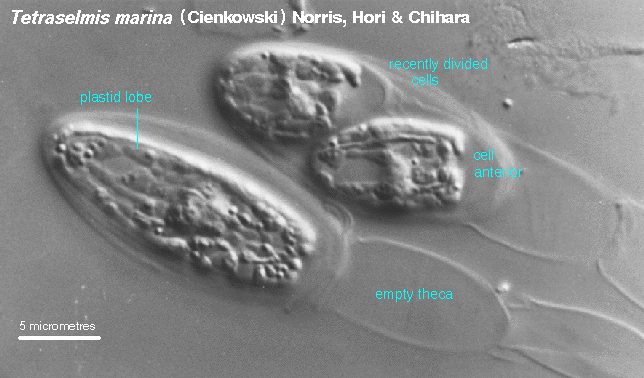
Tetraselmis cells usually are encountered as solitary, free-swimming, thecate cells with four flagella, and as solitary or colonial, stalked or unstalked, aflagellate sessile cells. Less commonly, cysts are found. Most species descriptions are based on the flagellate stage. The two species that are known best from aflagellate, stalked cells were, until 1980, placed in the genus Prasinocladus.

Flagellate and aflagellate vegetative cells may range from ca. 5 to ca. 25 micrometers in length; individual species may have characteristic size ranges within these limits. The cells usually are ellipsoidal to cylindrical in lateral view, and more or less flattened in end view. A thin wall layer is present in flagellate cells. At least one wall layer, and frequently several wall layers, may be observed surrounding aflagellate cells. Stalks produced by aflagellate cells may be composed either of discarded cell walls, yielding a segmented stalk, or of other materials (the stalk is unsegmented). At one end of the cell is a more or less prominent depression, from which the flagella emerge in flagellate cells through the one pore in the cell wall. The four flagella are slightly shorter than the cell body. Each cell contains a single pyrenoid, located more or less in the midregion of the cell; cells without pyrenoids are placed in the genus Scherffelia.

The pyrenoid is embedded in the single chloroplast, which occupies most of the volume of the cell, especially near its proximal end. The chloroplast may or may not be dissected into lobes and strands of various sizes. The plastid color is usually green, but in a few species it may bereddish due to the accumulation of "haematochrome" (one or more of the reddish-colored carotenoid or xanthophyll pigments). The single nucleus is located near the anterior end of the cell, directly beneath the flagellar bases. It is rarely visible without staining or other special microscopical tricks.
Cysts are spherical, and have a thick organic cell wall that may be ornamented with spines or other protuberances.
Return to summary information